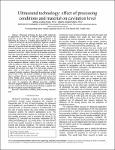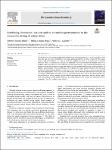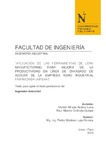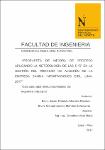| dc.contributor.author | Lindsay Rojas, Meliza | |
| dc.contributor.author | Claudio Miano, Alberto | |
| dc.date.accessioned | 2023-10-16T17:25:24Z | |
| dc.date.available | 2023-10-16T17:25:24Z | |
| dc.date.issued | 2021-09-08 | |
| dc.identifier.citation | Lindsay, M., & Claudio, A. (2021). Ultrasound technology: effect of processing conditions and material on cavitation level. Proceedings of the LACCEI International Multi-conference for Engineering, Education and Technology, 44, 21-23. http://dx.doi.org/10.18687/LACCEI2021.1.1.44 | es_PE |
| dc.identifier.other | . | es_PE |
| dc.identifier.uri | https://hdl.handle.net/11537/34464 | |
| dc.description.abstract | Ultrasound technology has been widely studied for
its application in food area to improve different processes and
properties of food. The most used form of application is by
immersing the product in a medium placed directly or by using
containers. During the ultrasound application, different conditions
such as powers, media for the transmission of waves, container
materials, or pressure levels have been applied. However, it has not
yet been described how these conditions impact the level of acoustic
cavitation. In this work, by using an ultrasound bath with 40 kHz
and power levels (30% - 100%), the effect of the position of beakers,
their type of material (plastic and glass), the type of medium (water
and ethanol) and pressure (atmospheric and vacuum), in the
acoustic cavitation level was studied. As results, the acoustic
cavitation level increased as the power level increased. The position
in the transducers allowed a higher level of acoustic cavitation,
while the influence of the type of material in the acoustic cavitation
depended on the power level. At 100% power, the acoustic
cavitation decreased by more than 14% when using containers of
glass, while, at 30% power level, cavitation highly increased
compared to plastic containers. Regarding the medium type, at high
power levels (>70%), the acoustic cavitation in water was greater
than in ethanol. However, it remained similar at low power level
(30%). Finally, when vacuum was used, cavitation decreased in
both media, but the level of reduction was greater when the medium
was water. In conclusion, the different processing conditions
showed a significant impact on the level of acoustic cavitation. This
must be considered when the ultrasound technology is applied since
the observed effects in food will depend on this. | es_PE |
| dc.format | application/pdf | es_PE |
| dc.language.iso | spa | es_PE |
| dc.publisher | Latin American and Caribbean Consortium of Engineering Institutions | es_PE |
| dc.rights | info:eu-repo/semantics/openAccess | es_PE |
| dc.rights | Atribución-NoComercial-CompartirIgual 3.0 Estados Unidos de América | * |
| dc.rights.uri | https://creativecommons.org/licenses/by-nc-sa/3.0/us/ | * |
| dc.source | Universidad Privada del Norte | es_PE |
| dc.source | Repositorio Institucional - UPN | es_PE |
| dc.subject | Ultrasound | es_PE |
| dc.subject | Cavitation | es_PE |
| dc.subject | Food processing | es_PE |
| dc.subject | Ultrasonic bath | es_PE |
| dc.title | Ultrasound technology: effect of processing conditions and material on cavitation level | es_PE |
| dc.type | info:eu-repo/semantics/conferenceObject | es_PE |
| dc.publisher.country | PE | es_PE |
| dc.identifier.journal | Proceedings of the LACCEI International Multi-conference for Engineering, Education and Technology | es_PE |
| dc.subject.ocde | https://purl.org/pe-repo/ocde/ford#2.11.00 | es_PE |
| dc.description.sede | Trujillo San Isidro | es_PE |
| dc.identifier.doi | http://dx.doi.org/10.18687/LACCEI2021.1.1.44 | |







